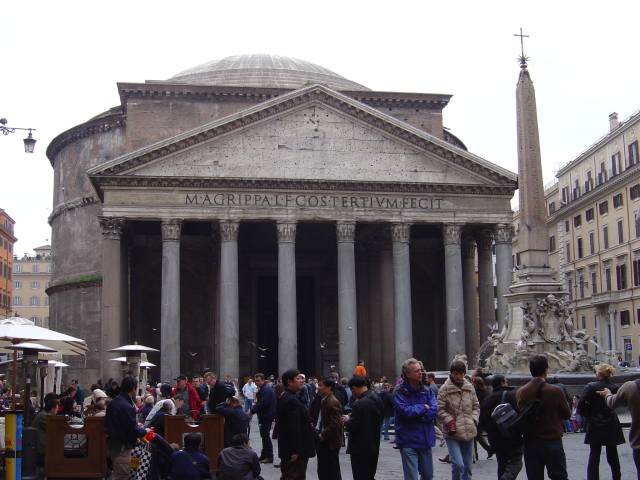
The Pantheon in Rome is one of the most stunning and well-preserved buildings that survives from antiquity. But could it have been more than just a temple? In today's issue of New Scientist I've written a news story about the idea that this domed building was actually a colossal sundial. An opening in the roof of the dome lets through a dramatic shaft of sunlight. During the six months of summer the noon sun falls on the walls and floor of the temple, and in winter (when the sun is lower in the sky) it falls onto the inside of the roof itself. But at the exact moment of the two equinoxes, in March and September, the sun falls at the junction between the roof and the walls, directly above the northern doorway, and shines through a grill there onto the porch floor beyond. The idea that the building was purposely designed to mark the equinoxes was suggested in the 1970s, but no one really picked up on it. Now an expert in timekeeping called Robert Hannah, who's based at the University of Otago in New Zealand, has discussed the idea in detail in his latest book, Time in Antiquity. Equinoxes occur when the Sun is on the celestial equator, and Hannah reckons that the Romans may have seen the equinox as a sacred time, when the Emperor could be raised up to dwell there with the gods.
Hannah now plans to look for other buildings and landscapes from the ancient Greek and Roman worlds that could have similar celestial significance. For example, he points out that if you stand at the Pnyx, which was the ancient political assembly area of Athens, to the west of the Acropolis, the midsummer sunrise appears directly behind the peak of Mount Lykabettos, a prominent hill to the northeast. The summer solstice was the point in time from which the Athenians measured the start of their calendar year. Hannah argues that ancient civilisations were much more aware then we are of how natural events signalled the passing of time, and he thinks they could well have used the sunrise behind Mount Lykabettos to mark the arrival of the new year.
I've written a short review of Time in Antiquity in the same issue of New Scientist. It's a lovely book about how the ancient Greeks and Romans marked the passing of the seasons and told the time. Among other things, Hannah gives a detailed analysis of the various calendars used on the Antikythera mechanism. But what makes it for me are the anecdotes from plays and poems, which give you a vivid taste of daily life in these societies. One play has a character who is a prostitute, nicknamed Clepsydra, which was the name for a type of water clock, because she used one to time her sessions with clients. Another features a guest invited to dinner when his shadow measures twenty feet long, but he's so eager for food that he measures it at dawn instead of dusk, and arrives hours early. But my favourite is probably a poem written by a Roman disgruntled that he can no longer eat when he wants because meal times are being set by new-fangled sundials. I used it in Decoding the Heavens too, here's that version:
The gods confound the man who first found out
How to distinguish hours! Confound them too,
Who in this place set up a sundial,
To cut and hack my days so wretchedly
Into small portions!